Original Source: AI Black Horse

Image Source: Generated by Wujie AI
Recently, the globally renowned information consulting firm Gartner released the "Top 10 Technology Trends for 2024" report on its official website, with Generative AI being selected for the first time and rated as one of the most disruptive technologies in the past decade.
Gartner's Top 10 Strategic Technology Trends report has a history of nearly 20 years and has always been regarded as a barometer for the IT information industry. It has accurately predicted the development trajectory of IT technologies multiple times, including big data, cloud computing, AI, autonomous driving, IoT, RPA, low code, AR/VR, and more.
The inclusion of Generative AI in this report is significant, indicating that Generative AI technologies such as ChatGPT and Wenzhen Yiyuan are in a rapid development stage, and have gained widespread recognition in terms of scenario-based implementation, technological innovation, and commercial value, moving towards a mature stage of technology.
Furthermore, the report mentions AI-augmented development and intelligent applications, which are also related to Generative AI, fully demonstrating the powerful influence of Generative AI across various industries.
Gartner's forecast shows that by 2026, over 80% of companies will use Generative AI APIs and models, a significant increase from the less than 5% in early 2023. This will democratize the knowledge and skills of the entire enterprise, allowing users to easily access a large amount of information sources.
01 Democratized Generative AI
Generative AI combines large-scale pre-trained models, cloud computing, and open source to democratize technology by allowing non-technical staff to create text, video, code, images, audio, and other content through text-based queries, making it one of the most disruptive technologies in the past decade.
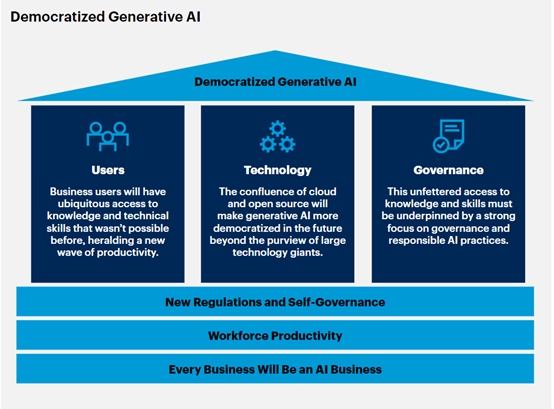
Gartner predicts that by 2026, over 80% of enterprises will use Generative AI APIs/models and applications that support Generative AI in production environments, a significant increase from less than 5% in 2023.

Why has Generative AI become a major technology trend?
Gartner believes there are 4 main reasons:
1) Promoting the use of Generative AI throughout the organization will greatly expand the scope of automation, effectively increase productivity, reduce costs, and drive new business growth opportunities;
2) Generative AI has the ability to change the competitive and operational methods of almost all enterprises;
3) Generative AI contributes to the democratization of information and skills, and will be widely applied in various roles and businesses;
4) Through the natural text patterns of Generative AI, employees and users can efficiently utilize a vast amount of internal and external enterprise data.
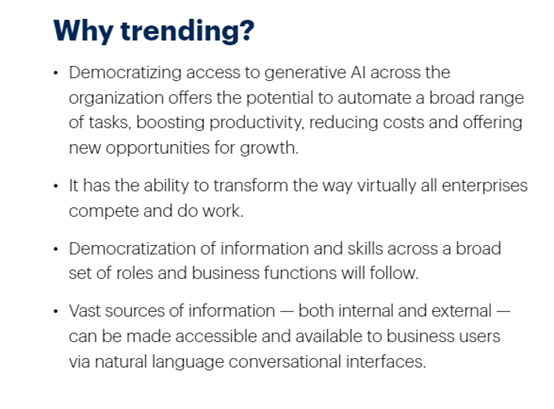
How to start applying Generative AI?
Gartner provides 3 recommendations:
1) Based on technological feasibility and business value, create a prioritized matrix of Generative AI application cases, and clearly plan the time frame for piloting, deploying, and producing these application cases;
2) Adopt a change management approach to prioritize providing employees with the knowledge to use Generative AI tools, enabling them to use them safely and confidently, and integrating them into employees' daily work as assistants for business automation;
3) Build a rapid-profit, differentiated, and transformative portfolio of Generative AI use cases, and test this portfolio with a hard investment return to see how Generative AI can help the enterprise financially while creating a competitive advantage.
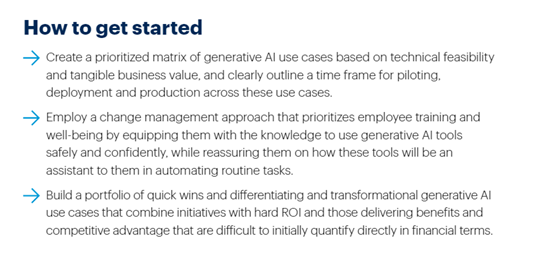
02 AI Trust, Risk and Security Management
AI Trust, Risk and Security Management
The democratization of AI has made the demand for AI Trust, Risk, and Security Management (TRiSM) more urgent and clear. Without guardrails, AI models may quickly generate multiple negative effects that are out of control, offsetting all the positive performance and social benefits brought by AI. AI TRiSM provides tools for model operations (ModelOps), proactive data protection, AI-specific security, model monitoring (including monitoring of data drift, model drift, and/or unexpected results), and risk control for third-party model and application inputs and outputs.
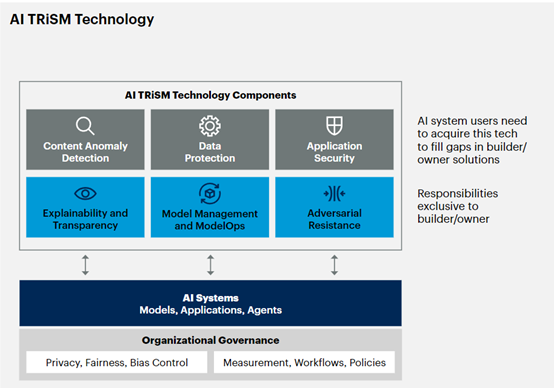
Gartner predicts that by 2026, enterprises adopting AI TRiSM control measures will improve decision accuracy by eliminating up to 80% of errors and illegal information.
03 AI-Augmented Development
AI-Augmented Development
AI-augmented development refers to using AI technologies such as Generative AI and machine learning to assist software engineers in application design, coding, and testing. AI-assisted software engineering enhances the productivity of developers, enabling development teams to meet the growing demands of business operations for software.
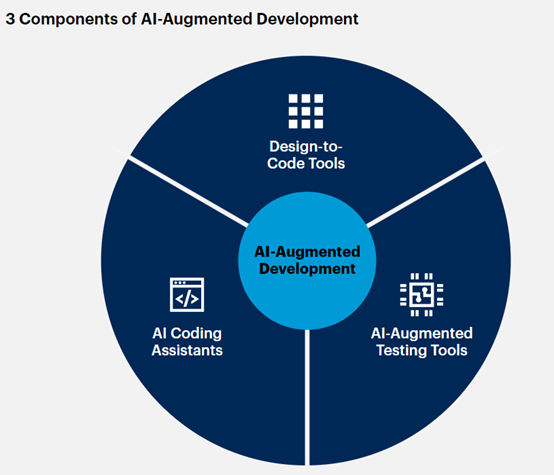
These AI-integrated development tools can reduce the time software engineers spend writing code, allowing them more time for strategically important activities, such as designing and integrating attractive business applications.
04 Intelligent Applications
Gartner defines "intelligence" in intelligent applications as the autonomous adaptive capability to make appropriate responses. In many use cases, this intelligence is used to better enhance work or increase the level of automation in work. As a foundational capability, intelligence in applications includes various AI-based services such as machine learning, vector storage, and connected data. Therefore, intelligent applications can provide continuously adaptive user experiences.
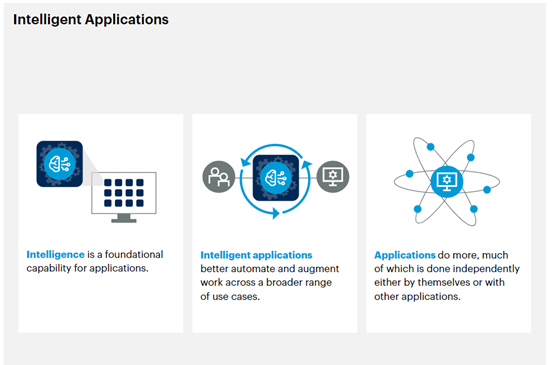
There is currently a clear demand for intelligent applications. In Gartner's 2023 CEO and business executive survey, 26% of CEOs identified talent shortage as the greatest risk to organizational disruption. Attracting and retaining talent is the top priority for CEOs in human resources, and AI is considered the technology with the greatest impact on their industry in the next three years.
05 Augmented-Connected Workforce
Augmented-Connected Workforce
The Augmented-Connected Workforce (ACWF) is a strategic approach to optimizing employee value. The demand for accelerating and expanding talent drives the development trend of ACWF. ACWF uses intelligent applications and workforce analytics to provide a daily environment and guidance that empowers the workforce experience, well-being, and self-skills development. Additionally, ACWF can bring about business outcomes and positive impacts for key stakeholders.
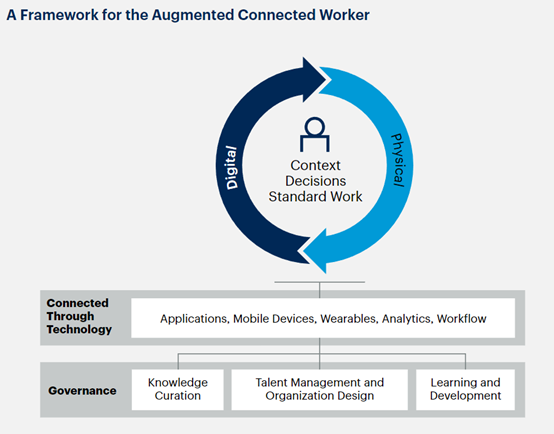
By the end of 2027, 25% of Chief Information Officers (CIOs) will use ACWF plans to reduce the time to competency for key positions by 50%.
06 Continuous Threat Exposure Management
Continuous Threat Exposure Management (CTEM) is a pragmatic and systematic approach that enables organizations to continuously and uniformly assess the accessibility, exposure, and exploitability of digital and physical assets. Adjusting the scope of CTEM assessments and remediation based on threat vectors or business initiatives (rather than infrastructure components) not only identifies vulnerabilities but also discovers threats that cannot be remediated.
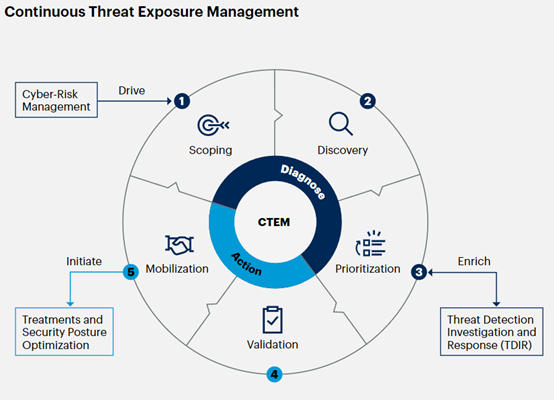
Gartner predicts that by 2026, enterprises prioritizing security investment based on CTEM plans will reduce two-thirds of vulnerabilities.
07 Machine Customers
Machine Customers (also known as "customer machines") are non-human economic actors that can autonomously negotiate and purchase goods and services in exchange for compensation. By 2028, there will be 15 billion connected products with the potential to become customers, and this number will increase by tens of billions in the following years.
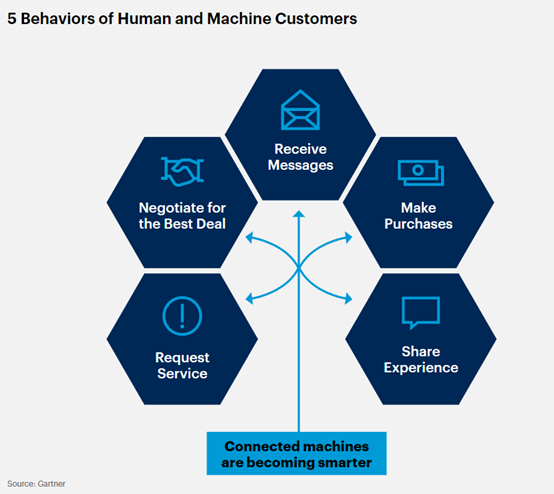
By 2030, this growth trend will generate trillions of dollars in revenue, and its significance will eventually surpass the emergence of digital commerce. Strategically, opportunities to provide convenience for these algorithms and devices and even create new types of customer machines should be considered.
08 Sustainable Technology
Sustainable Technology is a digital solution framework aimed at achieving environmental, social, and governance (ESG) outcomes that support long-term ecological balance and human rights. The use of technologies such as AI, cryptocurrency, IoT, and cloud computing is raising concerns about related energy consumption and environmental impact. Therefore, improving efficiency, circularity, and sustainability when using IT becomes increasingly important.
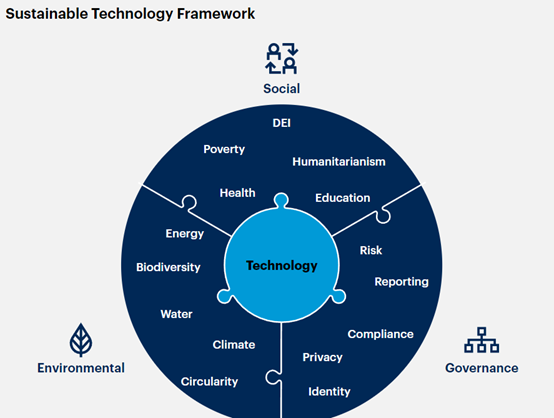
In fact, Gartner predicts that by 2027, 25% of CIOs' personal compensation will be tied to their impact on sustainable technology.
09 Platform Engineering
Platform Engineering is a discipline for building and operating self-service internal development platforms. Each platform is created and maintained by dedicated product teams and supports user needs through integration with tools and processes. The goal of platform engineering is to optimize productivity and user experience and accelerate the realization of business value.
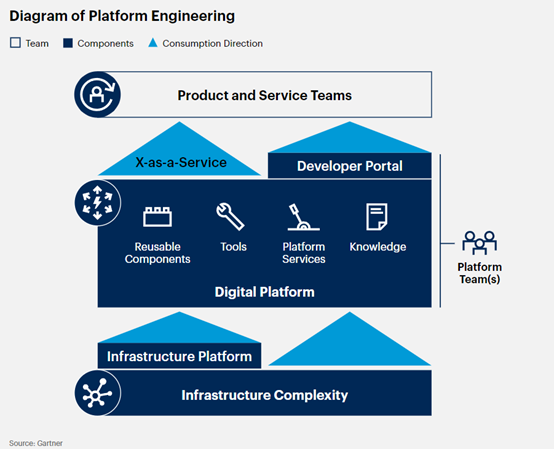
10 Industry Cloud Platforms
Gartner predicts that by 2027, over 70% of enterprises will use Industry Cloud Platforms (ICP) to accelerate their business initiatives, a significant increase from less than 15% in 2023. ICP integrates underlying SaaS, PaaS, and IaaS services into a full suite of products through composable capabilities, driving industry-related business outcomes. These capabilities typically include industry data weaving, packaged business function libraries, composite tools, and other platform innovation features. ICP is a tailored cloud solution designed for specific industries to further meet the needs of enterprises.
免责声明:本文章仅代表作者个人观点,不代表本平台的立场和观点。本文章仅供信息分享,不构成对任何人的任何投资建议。用户与作者之间的任何争议,与本平台无关。如网页中刊载的文章或图片涉及侵权,请提供相关的权利证明和身份证明发送邮件到support@aicoin.com,本平台相关工作人员将会进行核查。




